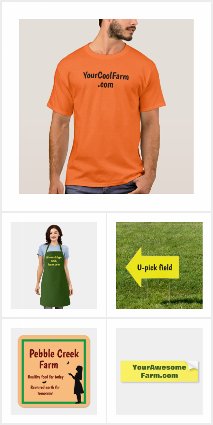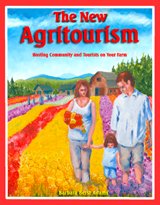Make money farming: Welcome back the (very) small local farm
Copyright National Lilac Publishing, LLC

Half Pint Farm, a 1 1/3 acre farm in Vermont, provides the full-time livelihood for its owners, a married couple who love what they do. They added a ½ acre greenhouse, but don’t plan to grow any larger, and say their small size is quite on purpose. They report after researching ancient to present-day farms worldwide, they found the best producers and most manageable and inspirational farms for couples are near this size. Keep the word “inspiration” in mind.
The micro eco-farm is an economic home business possibility once again for numerous reasons that all came together at once.
The new (and sometimes rediscovered) how-tos for producing huge amounts in small spaces -- such as wide-row, no-till planting -- are already developed. Technology for networking the information around the world to continue the progress is in place. Markets and demand for local, rare and artisan products grows continually.
And even the niche foods and fibers these small farms offer are expanding -- from farm-made world-cuisine artisan pepper sauces to rare sheep producing luxurious handspinners’ wool. The possibilities are almost endless. Some of the remaining barriers include ordinances that disallow residential-friendly urban micro-farms, and liability laws that are overactive with private producers, yet lax with large factories. In some locations, though, even these barriers are dissolving.
Though these new micro eco-farms can provide full-time incomes for individuals, couples and families, the notion of multiple streams of income allows part-time farming -- or cottage farming -- to also be taken seriously.
Think about this -- when an engineer marries a nurse, and they pool their incomes, no one suggests the engineer isn’t a “real” engineer, or the nurse isn’t a “real” nurse because his or her spouse has a job. Yet that archaic idea is still attached to farming. If an independent farmer doesn’t supply a family of five as the only source of income, and the spouse has another job, he or she isn't a “real” farmer.
That notion is changing. Public school teachers have grown autumn ripening market gardens during the summer for an October harvest festival for their schools as substantial second incomes. Executives find peace of mind with serious second incomes from backyard culinary mushroom operations. Wives or husbands have worked full time backyard farms as their own business, while their spouse is occupied in his or her own career.
They all collectively contribute to a food independent self-sustaining nation. And the backyard to small acreage market garden – whether selling as a CSA, through a farmer’s markets, or to restaurants -- is far from the only type of micro eco-farm helping our country bloom again.
A farm is defined as a tract of land producing agricultural products for profit. Besides those small fresh produce farms, the new micro eco-farms also include one-acre raw goat dairies, ten-acre lavender farms, three-acre apple orchards that grow medicinal herbs among the orchard floor, urban rooftop apiaries, two-acre wheatgrass operations, and farms that utilize agritourism and create their own custom farm design. As one example of that, one farm combines producing horse manure compost and vegetable garden starts for other people’s gardens along with giving non-riding children healing experiences with horses – which is contributing to local food in a more indirect way while using agritourism (giving people farm experiences as a source of revenue) as another income source that helps kids reconnect with nature.
And the most exciting reason concerning their return may be less obvious than most think. It’s because that for enough people, they’re fun. They’re inspiring.
Let me explain what power mere fun and inspiration have in a world some describe as on the brink of extinction.
When a livelihood is pleasant, meaningful, and pays well enough, it works itself into the economic fabric naturally. Self-owned small farms are the dream of many, and now they can pay well again. People want to operate them. That’s one of their most illusive yet fabulous values. The owners love what they’re doing and earn a good living, so therefore, they thrive.
As the last century turned, the idea that the small farm could prosper again was just emerging as a reality and wasn’t well known. That was the initial purpose of The Center for the Micro Eco-Farming Movement, to not only lead people to the how-tos already available and to demonstrate the many designs a small farm can take on, but to show the stories of those who have made the small farm dream a success, and how much they enjoy what they’re doing.
Sure, each new micro eco-farm is one less person, couple, or family suffering from unemployment. It’s another piece of land returning humus to the soil to restore the aquifer or sequester more excess greenhouse gas, or one more urban rooftop garden helping reverse global warming. It’s one more piece of an expanding world-wide green quilt that’s returning habitat for birds, frogs, honeybees and butterflies. And each contributes to food independence and their local economy.
But I recall the greatest yet most overlooked advice I got from an elder mentor years ago who said, “The one thing the environmentalists miss, is that saving the environment needs to be fun.” Humanity can go only so far on shame, guilt, panic and “shoulds.”
Fun, but not easy. The adventure of micro-farming can be full of challenges. Micro eco-farms aren’t for those who need a cookie cutter generic small farm formula. And they certainly aren’t here to displace their larger eco-farm cousins -- rather, they fill product openings that the larger farms aren’t involved with.
Each micro eco-farm is customized to one’s own interests, community needs and bio-region. Owners find niches and fill gaps. If they love growing locally adapted blueberries, but that niche is already filled with a local community u-pick berry patch, then they’ll find yet another blueberry niche or gap that isn't filled by the u-pick. Perhaps they’ll go around to all their local B&Bs and small inns to see if they can become their guaranteed supplier of fresh blueberry pies in the summer and blueberry jam in the winter. The adaptability and innovation to solve challenges are huge among successful owners of the new micro eco-farms. And isn't that just what a country would want as the generators of its renewed eco-farming backbone.




